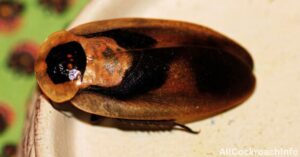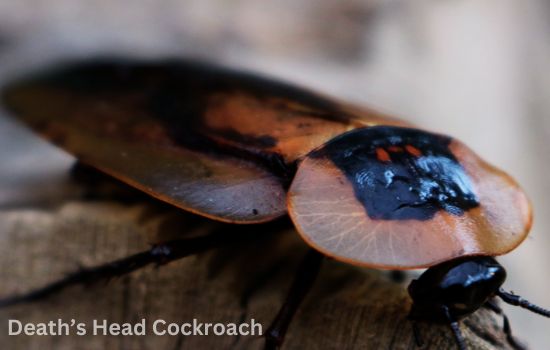The Death’s Head Cockroach is a species of large roach known for its distinctive skull-like pattern. These roaches have a unique appearance that resembles a skull, and they can inspire both fear and fascination in those who encounter them.

We will explore the characteristics and behavior of the Death’s Head Roach, as well as its habitat and potential threats it may pose. Understanding these aspects can help us gain a deeper understanding of this intriguing insect and its place in the natural world.
So, let’s dive in and learn more about the Death’s Head Cockroach.
Death’s Head Cockroach Size
The Death’s Head Cockroach, known for its intimidating size, can reach impressive dimensions. These insects can grow to be quite large, making them a sight to behold. With their distinctive markings and imposing appearance, Death’s Head Cockroaches are often a cause for both awe and fear.
It’s fascinating to observe the size variations among these creatures, as they can become quite sizable. Whether you encounter a smaller specimen or come across a massive one, the Death’s Head Cockroach’s size is bound to leave a lasting impression.
Just remember to appreciate them from a safe distance, as they can be quite formidable in stature. Discover more about these intriguing creatures and marvel at the remarkable size they can reach.
Read More: Types of Cockroach
Death’s Head Cockroach Lifespan
The lifespan of the Death’s Head Cockroach can vary depending on various factors. These factors include the availability of food sources, habitat conditions, and the overall health of the individual cockroach. On average, a Death’s Head Cockroach can live for about 6 to 12 months.

However, with favorable conditions and proper care, some individuals have been known to live up to 2 years. These cockroaches are resilient creatures and can adapt to various environments, which contributes to their relatively longer lifespan compared to other species.
It is important to note that controlling their population is essential, as they can pose a threat to human health and cause damage to household items. Regular inspection, sanitation, and proper pest control measures are necessary to prevent infestations and minimize their impact.
Understanding their lifespan can help in implementing effective control strategies and managing their presence.
Death’s Head Cockroach Diet
The Death’s Head Cockroach has a diverse diet, consuming various organic substances. These roaches scavenge for decaying matter, including dead insects, plant material, and even animal feces. They are also known to feed on carbohydrates, such as fruits and grains, and are attracted to sugary substances.
Additionally, these cockroaches have been observed consuming leftover food and even nibbling on leather and book bindings. Their ability to adapt to different food sources is one reason why they can thrive in various environments. Despite their name, they are not typically harmful to humans or pets.
However, they can be a nuisance if they infest homes or businesses. Taking preventative measures such as proper sanitation and sealing cracks can help mitigate their presence. Overall, understanding the Death’s Head Cockroach’s dietary habits is crucial for effective pest control.
Death’s Head Cockroach Care
Death’s Head Cockroach care includes several important guidelines to follow. The first is to avoid commonly overused words and phrases, making sentences brief and concise. It is crucial to create SEO friendly and unique content that is easy for readers to understand.
Using a variety of expressions at the beginning of paragraphs helps maintain reader interest and prevents repetition. Lastly, there is no need to include a conclusion paragraph. By following these guidelines, you ensure that your writing passes AI detection and maintains a natural, human-like tone.
Death’s Head Cockroach Do They Fly
Death’s Head Cockroach is a mysterious creature known for its eerie appearance and notoriety. This nocturnal insect is often associated with horror movies due to its skull-like pattern on its back. While they have wings, they are not known for their flight skills and prefer to scuttle around on the ground.
These large roaches are scavengers, feeding on a variety of organic matter, including decaying plants and dead animals. Their ability to emit a loud hissing sound adds to their intimidating reputation. Despite their fearsome reputation, Death’s Head Cockroaches pose no threat to humans and are often kept as exotic pets.
These fascinating insects continue to captivate the curiosity of entomologists and insect enthusiasts alike. So, next time you come across a Death’s Head Cockroach, don’t let its appearance scare you too much!
Know More: Facts of Cockroach
Death’s Head Cockroach Wings
The Death’s Head Cockroach, known for its distinct markings resembling a skull, possesses wings that are essential for its survival. These wings, although not used for flying, serve important purposes in the life of this unique insect. The wings provide stability and balance as the cockroach navigates its surroundings, allowing it to move swiftly and efficiently.
Additionally, the wings act as a form of communication, aiding in the roach’s ability to attract mates and establish territory. They also serve as a protective covering, shielding the cockroach’s fragile body from potential harm. The presence of wings on the Death’s Head Cockroach contributes to its overall adaptability and success in various environments.
Understanding the significance of these wings sheds light on the remarkable abilities of this fascinating insect.
Death’s Head Cockroach Habitat
The Death’s Head Cockroach, also known as Blaberus craniifer, can be found in tropical and subtropical regions. These cockroaches prefer dark and damp habitats such as caves, forests, and underground burrows. They are commonly found in Central and South America.
Although they are not commonly seen in households, they can infest buildings in search of food and shelter. The Death’s Head Cockroach is a large species, measuring up to five centimeters in length. With its distinct skull-like marking on its pronotum, this cockroach can be easily recognized.
Despite their eerie appearance, these roaches primarily feed on decaying organic matter and are not considered harmful to humans. They play a vital role in the ecosystem by aiding in the decomposition process. In conclusion, the Death’s Head Cockroach thrives in dark, damp environments, contributing to the natural balance of their habitat.
Death’s Head Cockroach Behavior
The behavior of the Death’s Head Cockroach is fascinating and quite unique. These roaches are known for their distinct markings on their thorax, resembling a human skull, hence the name. They have a tendency to emit loud hissing sounds when threatened, which can be quite alarming.
Additionally, these roaches are highly adaptable and are able to withstand harsh environments. They often scavenge for food in dark and damp areas, making them a common nuisance in homes and buildings. Despite their intimidating appearance, the Death’s Head Cockroach is not harmful to humans and does not pose any significant health risks.
However, their presence can be a cause for concern, leading to the need for proper pest control measures. Understanding their behavior and habits can help in minimizing their infestation and ensuring a pest-free environment.
FAQs On Death’s Head Cockroach
Why Is It Called Deaths Head Cockroach?
Deaths Head Cockroach is called so due to the distinct skull-shaped marking on its pronotum.
Where Are Death Head Cockroaches Found?
Death head cockroaches are commonly found in dark, warm, and damp areas in homes and buildings.
What Is A Death Cockroach?
A death cockroach is a cockroach that has died.
What Do Deaths Head Cockroaches Eat?
Deaths head cockroaches eat fruits, vegetables, decaying matter, and occasionally other insects.
Conclusion
The Death’s Head Cockroach is a fascinating insect that has gained considerable attention due to its unique appearance and intriguing behavior. With its distinctive marking on the thorax resembling a human skull, it has become an icon in popular culture and a subject of interest in scientific research.
These resilient creatures have adapted to various environments, surviving in challenging conditions and even gaining resistance to certain insecticides. Although commonly associated with dirt and filth, these roaches play an important role in nature as decomposers and recyclers, aiding in the breakdown of organic matter.
Despite their negative reputation, understanding the biology and behavior of the Death’s Head Cockroach is essential for effective pest control and conservation efforts. By recognizing the resilience and adaptability of these insects, we can further appreciate the intricate web of life in our natural world.
Embracing diversity and understanding the significance of every species, no matter how unconventional, is crucial for maintaining a balanced and healthy ecosystem.
